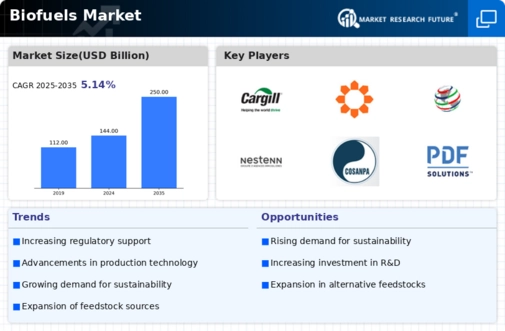Market Growth Projections
The Biofuels Market is projected to experience substantial growth over the coming years, with estimates indicating a market size of 144.0 USD Billion in 2024. This growth trajectory is expected to continue, with projections suggesting a rise to 250 USD Billion by 2035. The anticipated compound annual growth rate of 5.14% from 2025 to 2035 reflects the increasing adoption of biofuels across various sectors, including transportation and energy generation. This upward trend underscores the industry's potential to play a significant role in the global transition towards renewable energy sources, driven by both consumer demand and regulatory support.
Diverse Feedstock Availability
The availability of diverse feedstocks is a crucial driver for the Biofuels Market. Various agricultural residues, waste materials, and dedicated energy crops can be utilized to produce biofuels, providing flexibility and resilience to the supply chain. For instance, the use of waste cooking oil and agricultural by-products not only reduces waste but also enhances the sustainability of biofuel production. This diversity in feedstock options is likely to support the industry's growth, as it allows for localized production and reduces dependency on specific crops. Consequently, the market is expected to expand, aligning with the increasing global focus on sustainable energy solutions.
Government Policies and Incentives
Government policies and incentives play a pivotal role in shaping the Biofuels Market. Many nations are implementing tax credits, subsidies, and mandates to encourage the production and consumption of biofuels. For example, the Renewable Fuel Standard in the United States mandates a certain volume of biofuels to be blended into transportation fuels. Such regulatory frameworks not only stimulate market growth but also attract investments in biofuel production facilities. As a result, the industry is anticipated to grow significantly, with projections indicating a market size of 250 USD Billion by 2035, reflecting the positive impact of supportive government measures.
Rising Demand for Renewable Energy
The Biofuels Market experiences a robust increase in demand for renewable energy sources, driven by global initiatives aimed at reducing greenhouse gas emissions. Countries are increasingly adopting policies that promote biofuels as a sustainable alternative to fossil fuels. For instance, the European Union has set ambitious targets for renewable energy usage, which includes biofuels. This shift is projected to contribute to the market's growth, with the industry expected to reach a valuation of 144.0 USD Billion by 2024. The transition towards cleaner energy sources is likely to bolster investments in biofuel technologies, enhancing production capacities and market reach.
Technological Advancements in Biofuel Production
Technological advancements are transforming the Biofuels Industry by enhancing the efficiency and sustainability of biofuel production processes. Innovations such as advanced fermentation techniques and genetic engineering of feedstocks are enabling higher yields and lower production costs. For instance, the development of second-generation biofuels from non-food feedstocks is gaining traction, reducing competition with food supply. These advancements are likely to drive market growth, as they make biofuels more economically viable. The industry is projected to witness a compound annual growth rate of 5.14% from 2025 to 2035, underscoring the potential of technology to reshape the biofuels landscape.
Increasing Awareness of Environmental Sustainability
The Biofuels Market is significantly influenced by the growing awareness of environmental sustainability among consumers and businesses. As climate change concerns escalate, there is a noticeable shift towards eco-friendly fuel alternatives. This trend is evident in the rising consumer preference for biofuels, which are perceived as cleaner options compared to traditional fossil fuels. Companies are also adopting sustainable practices, further driving the demand for biofuels. This heightened awareness is expected to propel the market forward, contributing to its anticipated growth to 250 USD Billion by 2035, as stakeholders increasingly prioritize sustainability in their operations.

















